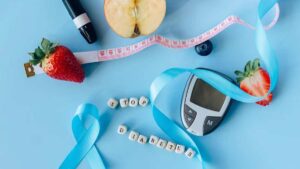Prediabetes, a condition marked by slightly elevated blood sugar levels that are not high enough to be classified as diabetes, often goes unnoticed. Without intervention, prediabetes can progress to type 2 diabetes, a condition that affects millions worldwide and brings along a host of complications. This blog post introduces an invaluable tool in the fight against diabetes: the online prediabetes test. By offering a convenient and accessible way to assess your risk, this test could be the wake-up call that leads to life-saving changes.
Contents
How Do I Know I’m Prediabetic?
 Knowing if you’re prediabetic involves understanding both the risk factors and warning signs associated with the condition. Prediabetes means your blood sugar levels are higher than normal but not high enough to be diagnosed as type 2 diabetes. This condition doesn’t always cause noticeable symptoms. This is why knowing the risk factors and any subtle warning signs is crucial. Here’s a detailed look:
Knowing if you’re prediabetic involves understanding both the risk factors and warning signs associated with the condition. Prediabetes means your blood sugar levels are higher than normal but not high enough to be diagnosed as type 2 diabetes. This condition doesn’t always cause noticeable symptoms. This is why knowing the risk factors and any subtle warning signs is crucial. Here’s a detailed look:
Risk Factors for Prediabetes
- Family History: Having a parent or sibling with type 2 diabetes increases your risk.
- Weight: Being overweight or obese, particularly with excess fat around the abdomen.
- Age: The risk increases as you get older, especially after age 45, although it’s becoming more common in younger adults, adolescents, and children due to rising obesity rates.
- Physical Inactivity: Less physical activity means higher risk.
- Gestational Diabetes: Women who have had gestational diabetes during pregnancy or who have given birth to a baby weighing more than 9 pounds.
- Polycystic Ovary Syndrome (PCOS): Women with PCOS are at increased risk.
- High Blood Pressure and Abnormal Cholesterol Levels: Especially if your HDL (“good”) cholesterol is low and your triglyceride level is high.
Prediabetes often has no clear symptoms. However, one possible sign of prediabetes is darkened skin on certain parts of the body, such as the neck, armpits, elbows, knees, and knuckles, a condition known as acanthosis nigricans. This is one of the few visual clues that may indicate higher insulin resistance, which is associated with prediabetes.
If you have risk factors for prediabetes, it’s important to get tested. Early diagnosis and action can prevent the progression of type 2 diabetes.
How To Take Online Prediabetes Test?
 Taking an online prediabetes test is a straightforward process that can provide you with a preliminary assessment of your risk for developing prediabetes. These tests, usually based on questionnaires, assess various risk factors like age, weight, family history, and other health-related questions. Here’s a step-by-step guide on how to take one:
Taking an online prediabetes test is a straightforward process that can provide you with a preliminary assessment of your risk for developing prediabetes. These tests, usually based on questionnaires, assess various risk factors like age, weight, family history, and other health-related questions. Here’s a step-by-step guide on how to take one:
Find a Reputable Online Test
- Research for Reputable Sources: Look for online prediabetes tests offered by recognized health organizations, such as diabetes associations, governmental health departments, or renowned medical institutions.
- Verify the Test’s Credibility: Ensure the test is based on scientifically validated research and endorsed by health professionals.
Prepare Your Information
- Gather Necessary Information: Most tests will ask about your age, gender, family history of diabetes, height, weight, blood pressure, and any history of gestational diabetes or heart disease. Having this information handy can help you answer the questions more accurately.
Take the Test
- Answer Questions Honestly: Accurately respond to all the questions based on your current health status and medical history. The accuracy of the test results depends largely on the honesty and precision of your answers.
- Submit Your Responses: Once you’ve answered all questions, submit your responses to generate your risk assessment.
Interpret the Results
- Understand Your Risk Level: The test will typically provide you with a score or a classification of your risk level for developing prediabetes. This might range from low to high risk.
- Read Recommendations: Pay attention to any advice or recommendations provided with your results, such as lifestyle changes or suggestions to see a healthcare provider for further testing.
By following these steps, you can use an online prediabetes test as a helpful tool in managing your health. However, always remember that such tests are just a starting point for understanding your health risks. Hence, should be complemented with professional healthcare advice.
What Is The Best Test For Prediabetes?
The best test for prediabetes is one that accurately measures your blood sugar levels to determine if they’re higher than normal but not high enough to be classified as type 2 diabetes. Below is a list of three main tests that are commonly used:
A1C Test
The A1C test stands out for its convenience and the comprehensive glimpse it provides into an individual’s blood sugar levels over several months. By measuring the percentage of hemoglobin — a protein in red blood cells that carries oxygen — coated with sugar, the A1C test reflects the average glucose levels in your blood for the past two to three months. Results falling between 5.7% and 6.4% indicate prediabetes, signaling that blood sugar levels are higher than normal but not yet high enough for a diabetes diagnosis.
Fasting Plasma Glucose (FPG) Test
This test requires an individual to fast for at least eight hours before their blood is drawn, making it slightly less convenient than the A1C test. However, its utility lies in measuring the immediate level of glucose in the blood. And, offering a snapshot of blood sugar levels at a single point in time. A result ranging from 100 to 125 mg/dL is considered prediabetes. Because it’s easy to perform and widely accessible, the FPG test is a common initial screening tool for glucose abnormalities.
Oral Glucose Tolerance Test (OGTT)
Lastly, the Oral Glucose Tolerance Test (OGTT) is particularly revealing for individuals whose A1C and FPG test results don’t fully align with clinical assessments based on symptoms or risk factors. Starting with a fasting blood sugar measurement, the OGTT includes a second test two hours after the person drinks a glucose-rich beverage. This process helps to evaluate how well the body processes glucose. A blood sugar level between 140 and 199 mg/dL after the second test points to prediabetes. The OGTT is sensitive and effective, especially in cases where other tests might miss borderline cases, making it invaluable for a thorough assessment.
The best test for diagnosing prediabetes depends on various factors, including your specific health situation, convenience, and whether or not you need to fast before the test. Your healthcare provider can help determine which test is most appropriate for you based on your health history and risk factors. Often, more than one test is used to confirm a diagnosis of prediabetes.
How Can I Reverse The Prediabetes?
 Reversing prediabetes and lowering your risk of developing type 2 diabetes involves making significant lifestyle changes. These changes aim to improve your body’s sensitivity to insulin and manage your blood sugar levels more effectively. Here’s a comprehensive approach to reversing prediabetes:
Reversing prediabetes and lowering your risk of developing type 2 diabetes involves making significant lifestyle changes. These changes aim to improve your body’s sensitivity to insulin and manage your blood sugar levels more effectively. Here’s a comprehensive approach to reversing prediabetes:
Adopt a Healthy Diet
- Choose High-Fiber Foods: Focus on fruits, vegetables, whole grains, and legumes. Fiber helps control blood sugar levels.
- Limit Sugary and Refined Carbohydrates: Foods high in sugar and refined carbs can spike blood sugar levels. Opt for whole, unprocessed foods instead.
- Incorporate Lean Protein: Including lean meats, poultry, fish, or plant-based proteins can help maintain muscle mass and support a healthy metabolism.
- Select Healthy Fats: Sources like avocados, nuts, seeds, and olive oil can improve heart health without spiking your blood sugar.
Increase Physical Activity
- Aim for Moderate Exercise: The American Diabetes Association recommends at least 150 minutes of moderate-intensity aerobic activity per week, such as brisk walking, cycling, or swimming.
- Include Strength Training: Muscle helps use blood sugar for energy, so incorporating strength training exercises at least two days a week can be beneficial.
- Stay Consistent: Consistency is key. Find activities you enjoy to make it easier to stick with your exercise routine.
Lose Excess Weight
- Target Modest Weight Loss: Losing 5% to 7% of your body weight can significantly reduce your risk of developing type 2 diabetes if you’re overweight or obese.
- Focus on Sustainable Changes: Small, incremental changes in your diet and exercise habits are more sustainable long-term than drastic, quick fixes.
Manage Stress
- Practice Stress-Reduction Techniques: Stress can affect blood sugar levels, so practices like mindfulness, meditation, yoga, or even deep-breathing exercises can help keep stress in check.
Monitor Your Health
- Regular Check-Ups: Keep regular appointments with your healthcare provider to monitor your blood sugar levels and adjust your plan as needed.
- Self-Monitoring: Consider monitoring your blood sugar levels at home with a glucose meter, especially if you’re making significant lifestyle changes.
Limit Alcohol and Quit Smoking
- Moderate Alcohol Consumption: Excessive alcohol can affect blood sugar levels. If you choose to drink, do so in moderation.
- Quit Smoking: Smoking increases the risk of type 2 diabetes and can complicate managing blood sugar levels.
Implementing these strategies requires commitment and patience. It’s also helpful to involve family and friends for support and to consider professional guidance from a healthcare provider, dietitian, or certified diabetes educator.
Conclusion
In conclusion, taking an online prediabetes test is a simple and convenient first step toward understanding your risk of developing type 2 diabetes. While these tests should not replace professional medical advice, they can serve as a wake-up call to take your health into your own hands. If your test results indicate a higher risk, it’s important to follow up with a healthcare provider for further evaluation and to consider making lifestyle changes.
By adopting healthier habits, you can significantly lower your risk of prediabetes progressing to diabetes. Remember, early detection and action can make all the difference in prevention. Do you want to get rid of diabetes? Join our online diabetes treatment program and reverse Diabetes naturally through lifestyle changes such as a Personalized Diet plan, Exercise, Yoga, dieticians, and health coaches.

